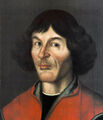Template:Selected anniversaries/May 24: Difference between revisions
No edit summary |
No edit summary |
||
| Line 22: | Line 22: | ||
||1868 – Charlie Taylor, American engineer and mechanic (d. 1956) | ||1868 – Charlie Taylor, American engineer and mechanic (d. 1956) | ||
||1906: Harry Hammond Hess born ... geologist who made the first comprehensive attempt at explaining the phenomenon of seafloor spreading (1960). This revived Alfred Wegener's earlier theory of continental drift. Together, these provided an interpretation of the earth's crust in terms of plate tectonics. The surface of the globe is not continuous. Rather, it is broken into a number of huge plates that float on the molten rock under the crust, moved over eons of geologic time by convective currents driven by earth's internal heat. With this motion these plates rub against, collide with, or separate from other plates. Thus the nature of earthquakes and volcanoes could be explained, plus the existence of ridges of young rock mapped around the globe under the ocean where the sea floor was spreading. Pic. | |||
||Herbert Lawrence Anderson (b. May 24, 1914) was a Jewish American nuclear physicist who contributed to the Manhattan Project. He was also a member of the team which made the first demonstration of nuclear fission in the United States, in the basement of Pupin Hall at Columbia University. He participated in the first atomic bomb test, codenamed Trinity. Pic. | ||Herbert Lawrence Anderson (b. May 24, 1914) was a Jewish American nuclear physicist who contributed to the Manhattan Project. He was also a member of the team which made the first demonstration of nuclear fission in the United States, in the basement of Pupin Hall at Columbia University. He participated in the first atomic bomb test, codenamed Trinity. Pic. | ||
Revision as of 11:38, 19 August 2018
1089: Celebrated jurist and monk Lanfranc dies.
1543: Mathematician and astronomer Nicolaus Copernicus dies. He formulated a model of the universe that places the Sun rather than the Earth at the center of the universe.
1686: Physicist and engineer Daniel Gabriel Fahrenheit born. He will help lay the foundations for the era of precision thermometry by inventing the mercury-in-glass thermometer and the Fahrenheit scale.
1734: Chemist and physician Georg Ernst Stahl dies. His works on phlogiston continue to be accepted as an explanation for chemical processes until the late 18th century.
1928: Mathematician Bertram Kostant born. He will be one of the principal developers of the theory of geometric quantization.
1940: Igor Sikorsky performs the first successful single-rotor helicopter flight.
1944: Field Report Number One (Peenemunde edition) reveals Nazi efforts to use Gnomon algorithm functions for rocket propulsion.
1963: Plutonium used for crimes against mathematical constants, says John Brunner.






